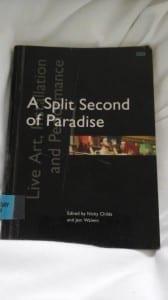Again, if you have been following along with these series of post, I am going to do something slightly different then all the post before this one. In this section Sacha Craddock talks about the work for Daniel Harvey and Heather Ackroyd. Now from the start of this journey I have been pondering what site specific performance actually entails? What turns a performance into a piece of site specific work and not just a performance outside of the theatre? Here I think Craddock has defined site specific art without intending to. For me this next section sums up what makes sight specific work so special.
Site-specific work often carries the ‘advantage’ of ready-made atmosphere around domestic decay and worn-down industry; there is always ample potential for nostalgia about past lives and existences (Craddock, 1998, 93).
At the heart of site specific work is the links to the spaces to its past, present and future. It allows both the audience to look at these ‘lost’ spaces and turn them into something new, whether it is by way for performance or by a piece of art. Site specific art connects to people in a way other methods of performance do not because, normally, it uses spaces that the audience all know and recognises and transforms the space into something different. A sceptical or an adventure. It uses people’s nostalgia and the atmosphere of the place to create an individual experience for each audience member.
xxx
First Blog post in the series
xxx
Work Cited.
Sacha Craddock. (1998) Force Field: The Work of Heather Ackroyd and Daniel Harvey. In: Nicky Childs and Jeni Walwin (eds.) A Spilt Second of Paradise: Live Art, Installations and Performances. London: Rivers Oram Press, 88-101.
